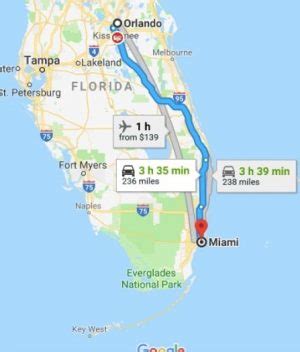Miami to Orlando Distance: Is it a Long Drive?
Planning a road trip from Miami to Orlando? The distance might seem daunting at first glance, but understanding the specifics can help you plan a smooth and enjoyable journey. This comprehensive guide explores the Miami to Orlando drive, addressing common questions and concerns to make your trip a breeze.
How Far is Miami from Orlando?
The driving distance between Miami and Orlando is approximately 240 miles (386 kilometers). This translates to roughly a 4-5 hour drive, depending on traffic conditions, chosen route, and the number of stops you make. While not an incredibly long cross-country journey, it's certainly a substantial drive that requires adequate planning.
Is the Drive from Miami to Orlando Long?
Whether the drive feels "long" is subjective and depends on individual preferences and tolerance for driving. For some, a 4-5 hour drive is perfectly manageable, while others might find it tiring. Several factors influence the perceived length of the trip:
- Traffic: Rush hour traffic, particularly around major cities along the route, can significantly increase travel time. Planning your trip to avoid peak hours is highly recommended.
- Stops: Frequent stops for gas, food, or restroom breaks will add to the overall travel time.
- Driving Style: A more relaxed driving style with frequent breaks will make the trip feel less rushed and more enjoyable.
- Passenger Comfort: Traveling with children or those prone to motion sickness may require more frequent stops and a slower pace.
What's the Best Route from Miami to Orlando?
The most common and generally fastest route is via the Florida Turnpike (Route 91). This toll road offers a relatively smooth and efficient driving experience, often bypassing much of the heavy traffic found on other routes. However, consider the toll costs when comparing this option to alternative, free routes.
Alternative routes exist, using Interstate 95, but these are often slower due to higher traffic congestion, especially around populous areas. Navigation apps like Google Maps or Waze can provide real-time traffic updates and suggest the optimal route based on current conditions.
What are Some Things to Do Along the Way?
The drive itself offers opportunities for sightseeing and rest stops. Depending on your chosen route, consider these possibilities:
- Rest Areas: The Florida Turnpike and I-95 both feature rest areas with restrooms, vending machines, and sometimes picnic areas. These provide a quick and convenient place to take a break.
- Tourist Attractions: Depending on your route and interests, you may find yourself passing by attractions that warrant a detour. Planning these in advance can enhance your road trip experience. However, be mindful of the extra time such detours will add to your journey.
- Lunch Stops: Plan for at least one lunch break. Numerous restaurants are located near the highway, catering to various tastes and budgets.
How Can I Make the Drive More Enjoyable?
Here are a few tips to enhance your Miami to Orlando road trip:
- Download Podcasts or Audiobooks: Keep yourself entertained and engaged during the drive.
- Create a Playlist: Music is a great way to set the mood and keep spirits high.
- Pack Snacks and Drinks: Avoid unnecessary stops by bringing along refreshments.
- Take Frequent Breaks: Regular breaks help combat fatigue and improve driving safety.
- Share the Driving: If possible, sharing the driving duties reduces driver fatigue.
Is it Cheaper to Fly or Drive from Miami to Orlando?
The cost comparison between flying and driving depends on several factors, including gas prices, toll costs, flight ticket prices, and parking fees at the airports. Generally, driving can be more cost-effective if you have a fuel-efficient vehicle and are traveling with multiple passengers, sharing the driving and costs. Flying offers speed and convenience but comes with baggage fees and the added expense of transportation to and from the airports.
In conclusion, the Miami to Orlando drive is a manageable journey, but requires planning to avoid unexpected delays and ensure a comfortable experience. Weighing the pros and cons of driving versus flying and considering factors like traffic, planned stops, and your personal driving preferences will help you make the best choice for your travel needs.

